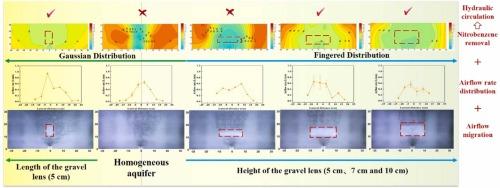Effects of hydraulic circulation induced by gravel lenses of varying sizes on nitrobenzene removal in heterogeneous aquifers during air sparging remediation
IF 12.2
1区 环境科学与生态学
Q1 ENGINEERING, ENVIRONMENTAL
引用次数: 0
Abstract
Air sparging (AS) technology is widely used in groundwater remediation of organic contaminants. In this study, using a two-dimensional physical model, the research explores how varying sizes of gravel lenses affect airflow distribution, hydraulic circulation, and contaminant removal efficiency. The presence of gravel lenses was found to significantly enhance hydraulic circulation, thereby improving the removal of nitrobenzene. The study revealed that the length and height of the gravel lenses play crucial roles in determining the airflow pattern and the extent of hydraulic circulation. A lens length of 5 cm was sufficient to form a hydraulic circulation zone, while a lens height of 4 cm was necessary for effective bubble migration. As the lens thickness increased, the bubble migration path extended, enhancing the bubble pulsation effect and the remediation zone. However, beyond the thickness of 10 cm, further increases in lens thickness did not significantly improve removal efficiency, likely due to stable gas-liquid mass transfer rates. The study concluded that gravel lenses were essential for establishing hydraulic circulation in AS processes, which could lead to more effective remediation strategies in heterogeneous aquifers. These findings provide valuable insights for optimizing AS system designs in complex geological settings.

求助全文
约1分钟内获得全文
求助全文
来源期刊

Journal of Hazardous Materials
工程技术-工程:环境
CiteScore
25.40
自引率
5.90%
发文量
3059
审稿时长
58 days
期刊介绍:
The Journal of Hazardous Materials serves as a global platform for promoting cutting-edge research in the field of Environmental Science and Engineering. Our publication features a wide range of articles, including full-length research papers, review articles, and perspectives, with the aim of enhancing our understanding of the dangers and risks associated with various materials concerning public health and the environment. It is important to note that the term "environmental contaminants" refers specifically to substances that pose hazardous effects through contamination, while excluding those that do not have such impacts on the environment or human health. Moreover, we emphasize the distinction between wastes and hazardous materials in order to provide further clarity on the scope of the journal. We have a keen interest in exploring specific compounds and microbial agents that have adverse effects on the environment.
 求助内容:
求助内容: 应助结果提醒方式:
应助结果提醒方式:


